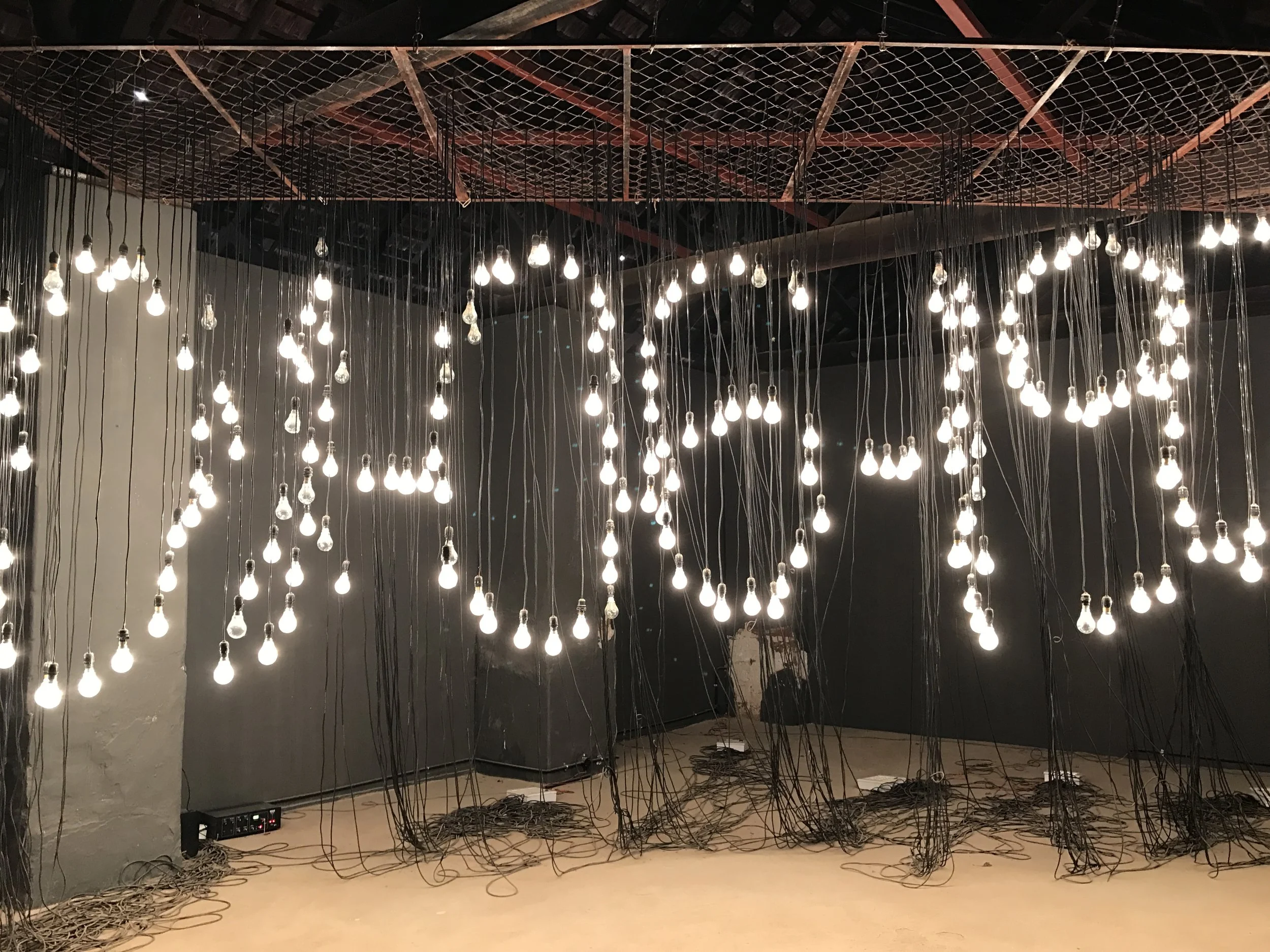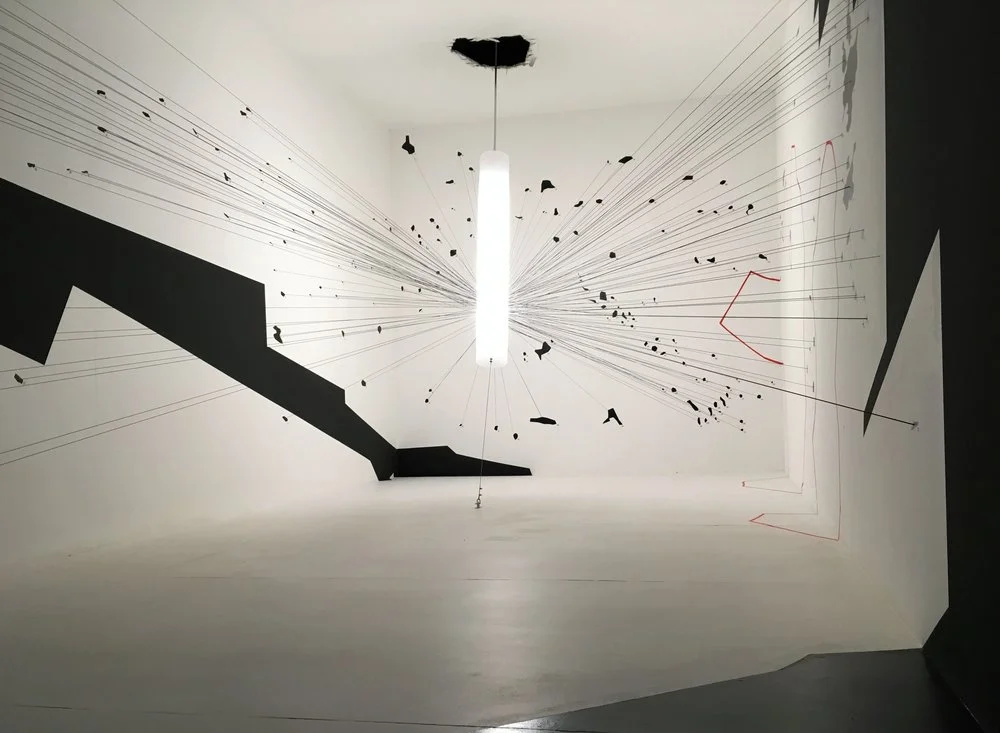A Peek into Kochi-Muziris Biennale, 2016-17
The third edition of the Kochi-Muziris Biennale (KMB), curated by Sudarshan Shetty, is a compelling edition, quite different from the previous two exhibitions under the banner founded by artists-curators Bose Krishnamachari and Riyaz Komu. From the onset, the Biennale has been conceived as a site-focused enterprise, having chosen the city of Kochi as its location. The Biennale functions to highlight the cosmopolitan modernity of the city as well as its historical past and entrenched multiculturalism of Fort Kochi, an area known from classical antiquity as an entrepot for travelers from across the world. This mix of local-specificity and cultural pluralism is also the ethos by which the curators of the biennale have put together all three editions (2012, 2014 and now, 2016) together.
The 2016 edition is titled "forming in the pupil of an eye." To explain the concept, Shetty takes you back into stories enshrined in the Rigveda, highlighting the layering of our vision and the multiplicities of images, how we process them, and, of our complicated existence. Under Shetty's curatorship, the biennale which is the largest contemporary art exhibition in South Asia, exhibits evocative displays: you see things but you also immerse yourself in that which you are seeing - the art and its immersive capabilities are at the forefront of the third edition of the biennale. Unsurprisingly, most exhibits and installations touch upon concepts of bodily experience and death and their relatedness. Many artists from India and abroad, meditate on death and the role of death in our lives; some of these artworks therefore lean towards macabre yet are truly contemplative. This focus on death appears to be an important "trend" in the art world currently. Most recently in 2017, MoMA hosted a two-hour panel on 'Modern Death'.
Following are few of our favorites from the Aspinwall venue, one of twelve locations around Kochi hosting KMB:
AES+F, Défilé 2000-2007


Défilé 2000-20007, a gallery of seven photographic images on light-boxes, rightly, make visitors intensely uncomfortable. Images lined one after the other on two walls of a dark gallery space starkly highlights the thing that you are looking at - dead, fast-decomposing people in really fancy clothes. The description explains the artists' intention of exploring the "relationship between death and beauty" and seeing both as a product most connected with time. Particularly poignant and uneasy was the act of taking pictures of the "display," the dark moment of death literally lit up by the use of lightboxes.
A peek into their website will tell you more about the strange, stark, and often macabre visuals that AES+F produces. Yet, these make you peer into your own fallacies in a visceral fashion. One of the deeply disturbing ones I liked from their portfolio: Who wants to live forever.
Liu Wei, Big Dog, 2006-2016



Liu Wei is a Chinese artist who works with atypical materials to create architecturally-inclined sculptures and installation pieces. At KMB 2016, Liu Wei uses oxhide, primary component in chew toys for dogs, to make scaled models of classical western architectural structures. The artist says that it is a space that is about "comical grotesque and indulgence," perhaps a soft critique of globalization and modernism. The space where the display is exhibited, in an old warehouse that was originally used for storing pepper and other exports in the nineteenth century, stands in stark contrast to the styles rendered by the artist in oxhide. For the visitor aware of Aspinwall House's colonial connections, it highlights the old colonial-era commerce that made possible some of these modern western edifices.
The exhibits also create a playful space, creating a cove of unusual forms and varied light. As the artist perhaps intended, it is also quite easy to imagine a big dog chewing on these magnificent buildings. For more on Lui Wei and his commentary on existentialism, see a review of his 2016 Lehmann Maupin show in New York on Art News.
Aleš Šteger, The Pyramid of Exiled Poets 2016
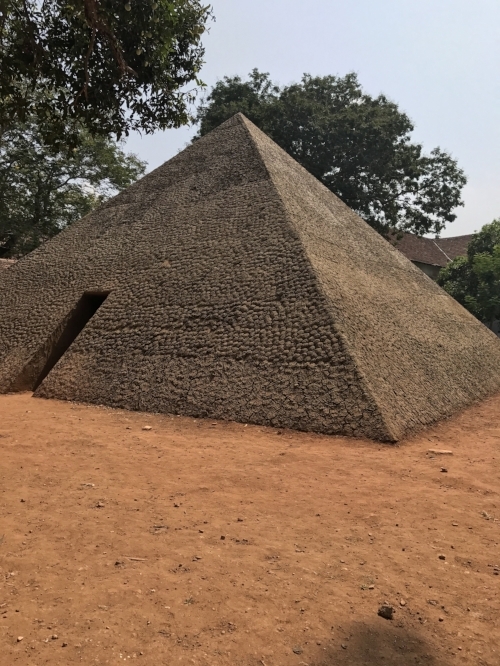
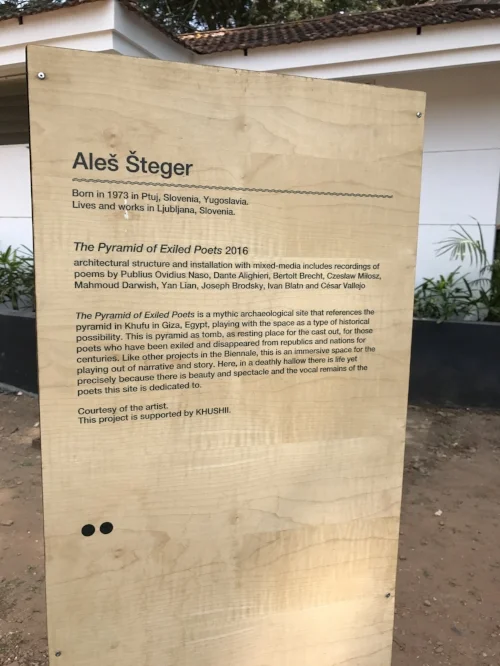
Aleš Šteger's "tomb" is a multisensorial ode to those poets who have, since time immemorial, suffered at the hands of authoritarian and fascist regimes. At a time when the world is once again looking inwards, with countries placing barriers on belonging to a place based on individual identity, Šteger's work has a particular resonance far beyond its immediate experiential appeal. You can find a detailed overview and for a video of Šteger's "maze" of darkness in this blog post.
Yuko Mohri, Calls 2013-16
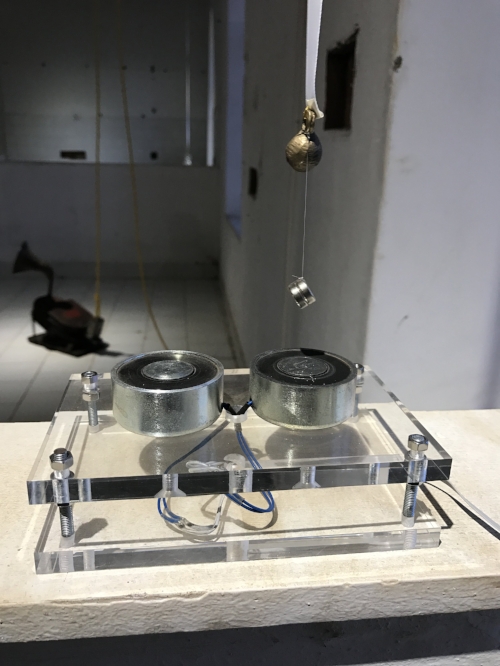

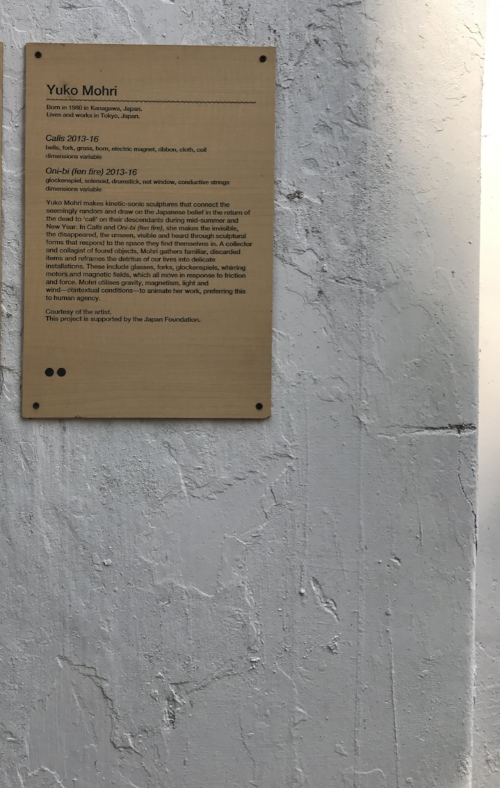
Mohri, a Japanese artist, who works with everyday found objects has two installations at the KMB 2016, Calls and Oni-bi (fen fire). The two installations take up one of the largest spaces within Aspinwall including the rooms that were originally a laboratory at the trading facility. Upon entering one-half of this space where Calls is installed, one hears the faint sound of what seems like tinkling bells. These sounds are made by metal objects such as bells tied to ribbons and hung over a magnetic contraption.
Once you get accustomed to the place, you realize the sounds have a particular rhythm disturbed by a particularly strong gust of wind or a human who moves too close to the display. The dynamic nature of the exhibit in combination with its sparsity produces a negative soundscape that makes you more aware of all the other sounds and sights around you.
Mohri's work has found display arenas across the world and most recently at Camden Arts Centre in UK.
Sunil Padwal, Room for Lies 2016
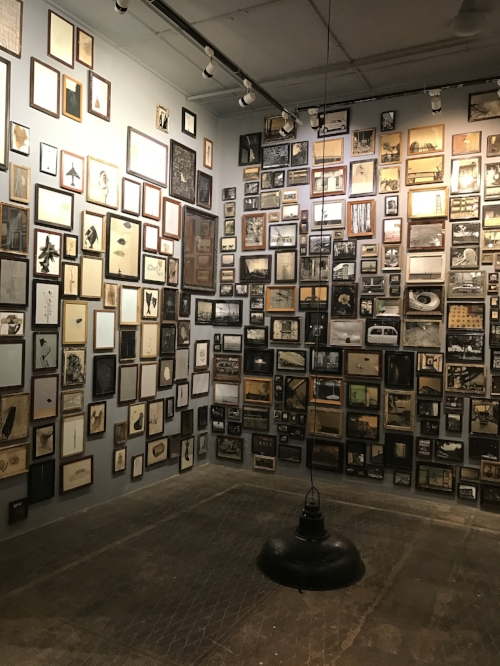


Padwal's Room for Lies is a wonderful space (set of multiple rooms) that will immediately transport you back to the comforts of that old pre-globalized Indian home where your grandfather sat on the hardbacked wooden sofa and read the newspaper for hours on end. It is a slice of an India that is no longer readily visible, or even wanted, except for nostalgic reasons. Perhaps, this is why the installation is called Room for Lies as none of the material displayed in the room are heirlooms--they are what Padwal has found and put together to create a space of nostalgic, at times melancholic, comfort. If it reminds you of the Dishoom Cafe in the UK, it is not your fault for the "decor" of both these spaces rely heavily on the old Bombay cosmopolitan interior.
Padwal's Room for Lies is also like a gigantic collage piece together to form a structure and pattern that arises from within itself. This treatment is an integral part of the make-up of this artist's oeuvre and can be seen in his previous works. The rooms are both busy and structured, traditional and modern, the many things in the space complementing one another and simultaneously, producing new and varied memories for each visitor. You can spend hours in this space, and the space consumes you with its detail--an old electric gauge meter's shutter becomes a frame for the sketch of a plant by the artist; photographs of old buildings and older cars abound; and a typewriter occupies pride of place. In many corners, tiny frames 3x3 inches in size hold photos of smiling kids and families--are they related to the artist? The Room for Lies offers no clue.
Bhagyanath Chandroth, Secret Dialogues


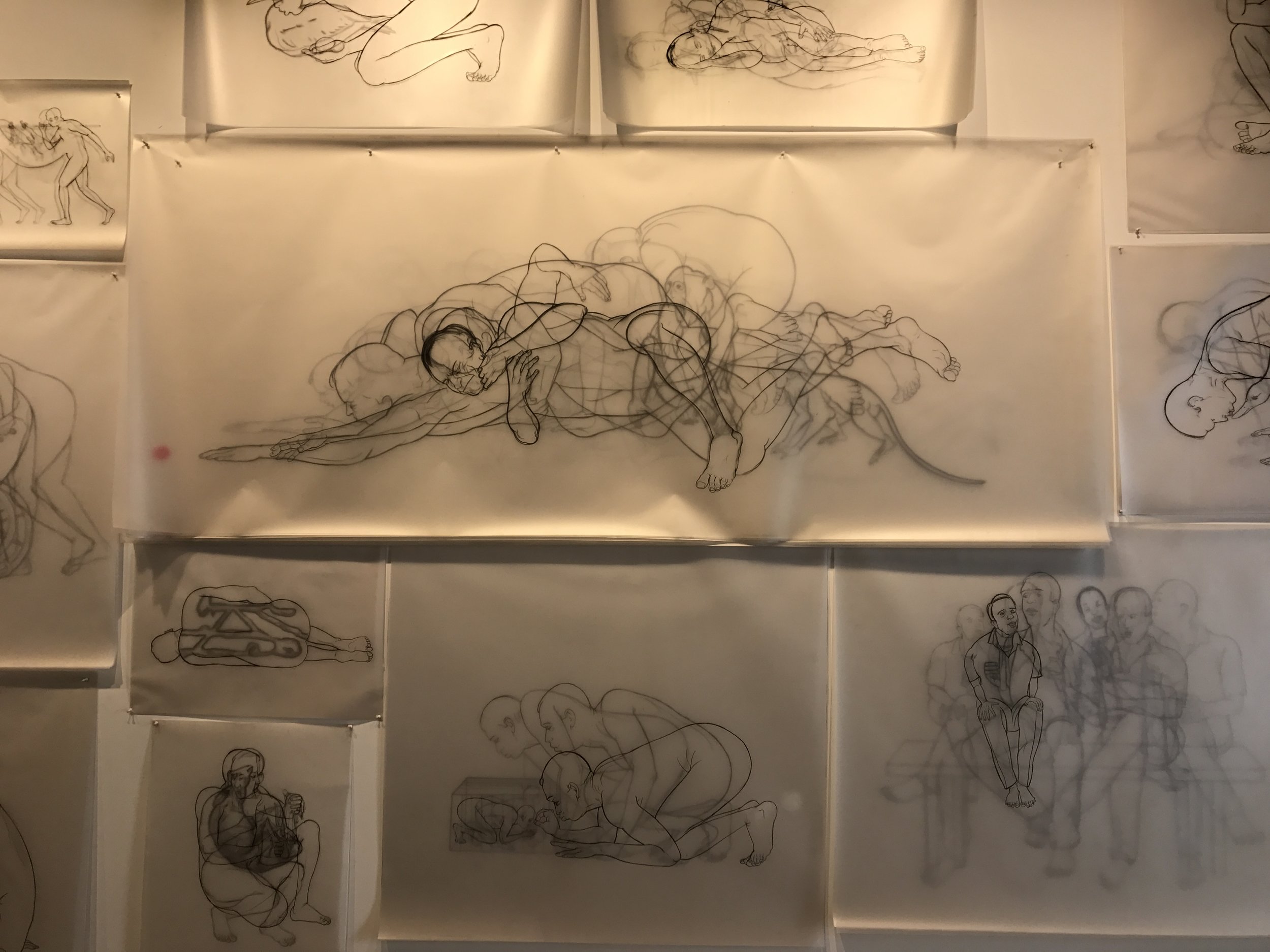
Chandroth is an artist from north Kerala who is traditionally a body painter for Teyyam folk dance forms. The many myriad movements often associated with Teyyam finds a place in Chandroth's alluring Secret Dialogues exhibit - a series of sketches on butter paper. Each exhibit consists of the same topic or figures represented in varying motion on layers of butter paper. The effect is mesmerizing--the layering offers the viewers a chance to see the multiplicity of narration and at times dizzying array of bodily movements. Each set provides a lens to look into the subjectivities of the person or people depicted.
You can listed to the artist talk about his work in this video (courtesy: Kochi-Muziris Biennale 2016):
Final Word: The 2016 Biennale edition has plenty to offer as just a select-few from just their Aspinwall venue provided here tells you. Very rarely do large-scale exhibits like these successfully integrate high concepts with simple narrative capacity that at once can make you question your responses to the wider sociopolitical world and at the same time provide you with the experience of something quite novel, and for that we have to thank the vision of curator Shetty. The approachability of the artworks is particularly commendable--many are interactive, and even when they aren't, the gallery guides police visitors minimally and kindly at that. For most of the visitors at the biennale who are new entrants into the world of experience contemporary art, this creates a welcoming atmosphere. No wonder it is called the 'people's biennale.'
The 2016 Kochi-Muziris Biennale is currently underway at various locations in Fort Kochi. It runs from December 12, 2016 to March 29, 2017.
Photographs: Deepthi Murali
Opinions: Deepthi Murali & Nabeel Basheer
Related Posts: South Asia at the 2016 Venice Biennale

